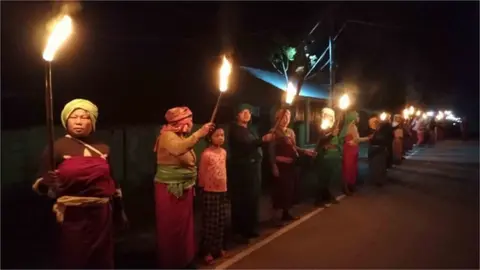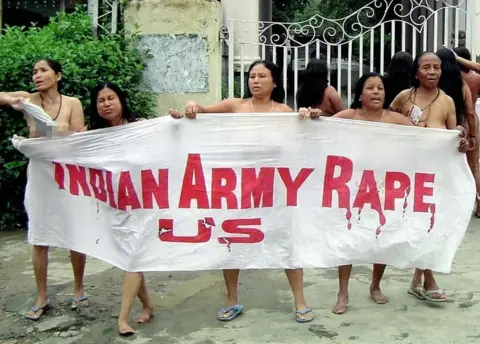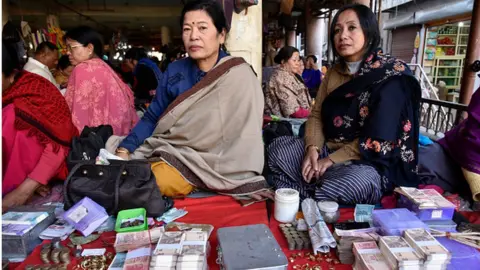Manipur: The daring women standing up to troops in Indian state

 Getty Images
Getty ImagesA recently shared video by the Indian army from the violence-wracked north-eastern state of Manipur captured a dramatic sequence of scenes.
The two-minute 14-second footage shows unarmed women confronting soldiers on a busy street. Aerial shots show women gathering around an excavator on a disrupted road, a bustling mix of SUVs, cars, an ambulance speeding along a scenic valley route and glimpses of agitated women.
Ethnic violence continues to roil Manipur, nearly two months after clashes between the majority Meitei and tribal Kuki communities left more than 100 dead and displaced some 60,000. This despite the presence of tens of thousands of security forces in the valley, inhabited primarily by the Meitei community, as well as in the hills, home to the Kukis.
But, as the video shows restoring peace is a slow and difficult journey in a climate of deep divisions and distrust. Titled 'Demystifying myth of peaceful blockade led by Manipur women', the video makes some pretty incriminating allegations.
For one, it alleged that women protesters were "helping rioters flee" and accompanying them in vehicles and ambulances. They were also "coming in the way" of security operations and movement of logistics, and digging up a route to a paramilitary base to "cause delay", it added. The video ended with an appeal to residents to cooperate with security forces who were "working day and night to bring peace and stability".
 AFP
AFPA second video shows a tense encounter between a group of agitated women and a patient soldier. "It doesn't matter. You go away," a woman tells the soldier, while other women gather around her. The army also tweeted last week that they had freed 12 local insurgents during a combing operation after they were "surrounded" by a 1,500-strong "mob" of women in the state capital Imphal's East district, where 16% of Manipur's estimated 3.3 million people live.
Many of the women challenging the security forces in the turbulent valley are believed to be Meira Paibis - 'women torchbearers' - also known as Imas or 'mothers of Manipur'. In 2004, they stunned the world by stripping naked outside a military camp in the capital, Imphal, while waving a banner that read 'Indian Army Rape Us', in a startling protest against the alleged gangrape and murder of a 32-year-old local woman by paramilitary soldiers.
Belonging to the majority Meitei community, the Meira Paibis are typically married women, aged between 30 and 65, with or without any official position. Loosely affiliated with the group, they are like a disciplined cadre, according to historian Laishram Jitendrajit Singh. Researchers trace their origins to the early 1900s when like-minded women initiated a successful protest against forced labour, wherein men in Manipur between the ages of 17 and 60 were obliged to provide free labour to the British ruler for a specified number of days each month.
 Getty Images
Getty ImagesSince Manipur's merger with India in 1949, the Meira Paibis have gained prominence for their relentless campaign against drug and alcohol abuse. "Being flexible and not having a rigid structure means they are able to take up any issue pertaining to their community. This also makes the Meira Paibis a group not confined to agitating strictly on women's issues," notes Shruti Mukherjee who's researching women's activism in Manipur at Stony Brook University.
When Manipur plunged into ethnic conflict and insurgency in 1980, these activist-vigilante women took on an expanded role. In 1958, India enacted the controversial Armed Forces Special Powers Act (Afspa), which protects security forces who may kill a civilian by mistake or in unavoidable circumstances. It has been partly blamed for the "perpetual immunity" enjoyed by the forces.
Rights groups allege that as many as 1,528 people were unlawfully executed - also known as fake encounters - by security forces in Manipur between 1979 and 2012. In 1980, the Meira Paibis marched to a police station and secured the release of a Meitei man who had been picked up by the security forces on suspicion of insurgency. The women "held night vigils with flaming torches or stood guard against the army taking away their boys by banging electric poles or beat a gong or banging bamboo poles on the ground," says Mr Singh.
In a state simmering with insurgency for over four decades, the deep-rooted mistrust between the people and security forces persists. Following the violent clashes in early May, three policemen from the local police's Rapid Action Force were accused of home burning and arson and suspended. There were allegations that some paramilitary soldiers owing allegiance to one community looked the other way when militants attacked some villages.
 Getty Images
Getty ImagesThongam Joymala, a Meira Paibi leader, says the women are "not happy with the role of army". "They are unable to stop armed Kuki miscreants [in the hills]. So there are sporadic protests against army movements in the valley. We believe the violence should be stopped, and operations [to flush out miscreants] conducted both in the hills and valley. Otherwise we will not support [army] operations," she says. Binalakshmi Nepram of Northeast India Women Initiative for Peace echoes a similar sentiment. "The 'mothers of Manipur' feel that certain sections of security forces were deliberately creating further division and hate. Hence, they have come out in thousands to protect Manipur," she says.
Ms Nepram says rather than sharing the video on social media, the army should have "shown the courage" to engage with Meira Paibi leaders and worked with them and Kuki women to help restore peace. "Without the inclusion of the women of Manipur, sustainable peace cannot return to the state."
Few will deny that. Though not a matrilineal society, women participate actively in public affairs in Manipur. In Imphal, they run the biggest all-women's market in South Asia. To protest atrocities by armed forces, an activist named Irom Sharmila went on a hunger strike for 16 years, cloistered in a hospital room in Imphal, surrounded by armed guards and nurses. In conflict-ridden neighbourhoods, local women now patrol the militarised buffer zones.
Women in Manipur have participated in two major mass movements - called 'Nupi Lan' or women's war - against British rulers in 1904 and 1939. For the "torch bearers of Manipur this is the third non-violent, courageous war of women," says Ms Nepram. The Meira Paibis seek peace, says Ms Joymala. "Our farmers are not able to go to their fields. Our 'mothers' are not able to go to the market and make a living. We are living in a siege."
With additional reporting by Dhiren A Sadokpam in Imphal
BBC News India is now on YouTube. Click here to subscribe and watch our documentaries, explainers and features.

Read more India stories from the BBC:

